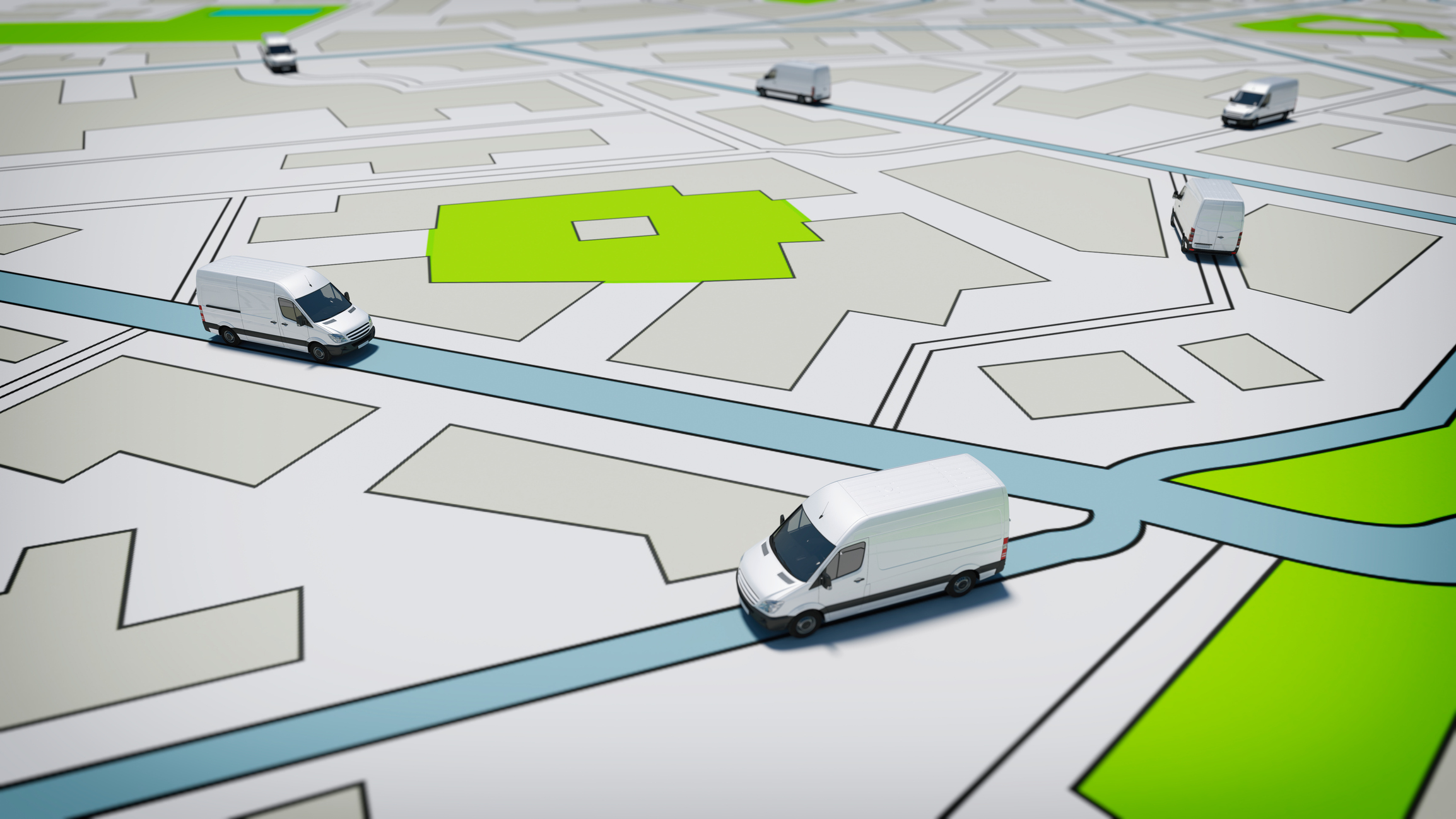Your ultimate guide to vehicle route planning

What is vehicle route planning? Route planning is the process of organizing your delivery operation. You have customers, orders, vehicles, and drivers, so what is the most effective route to use to get your items to the right place at the right time.
Route plans can come in various shapes and sizes:
- Fixed routes
Your drivers and vehicles follow the same route every day, or on the same day each week. Customer order volumes don’t vary massively, and drivers get to know their customers well.
- Regional routes
You send vehicle one into region 1 on a Monday, on Tuesday that vehicle goes into region 2. Regions might be groups of postcodes, or geographical areas, but what it means is that you have a fixed plan and allocate delivery days to customers accordingly.
- Daily dynamic routes
You plan your vehicle movements based on orders for a particular day. You don’t always know what’s going where when, so you need to create a plan, after order cut off, that gets jobs done in the most time and fuel efficient way, while keeping your vehicle weights legal.
- Full load routes
You have fully loaded vehicles moving from point A to point B. These may be ‘trunking routes’ which is the process of making deliveries via regular routes (think Royal Mail HGVs driving up and down the motorway every day and night, going south to north and back again). Or you might just be delivering a fully loaded truck to a particular site on a particular day.
Each scenario has its challenges. But whatever way you are looking to organise your route plans there are opportunities to be had and savings that you can make.
Why is route planning and vehicle optimisation so important?
Running a distribution operation is expensive, as you well know. Total up fuel, labour, warehousing and vehicles and you could be looking at a hefty bill each month. But how well are you utilizing the resources you have? How are you controlling costs and maximizing efficiency? Well, one way is to take the guesswork out of how you plan and optimise your routes.
Manually planning delivery routes is a very complex task and one which many individuals have perfected over the years. It’s a skill, but issues can occur when staff leave a business, are off sick, or are seconded into another department. Having all that knowledge in one person, or just a small team, can be risky.
Now, no automated system will ever replace an experienced planned and anyone that tells you otherwise doesn’t understand what they are dealing with. But there are solutions out there designed to make the process easier, using algorithms to suggest alternatives, give you a visual overview of what you are planning, allow you to make considered decisions based on the whole picture of what’s going on every day.
Route planning and vehicle optimisation best practice
Today’s route planning best practice tends to involve the use of some form of automated system or optimisation planning tool. There will always be a human element to whatever you do but route optimisation solutions can take away some of the guesswork involved in manual planning and help share the knowledge across teams. They also give you visibility of what’s going on throughout your whole operation, from job receipt to order planning, driver tracking and actual proof of delivery.
If you still rely on manual or paper-based processes, then it’s worth looking at what the market has to offer.
How do I find the right route planning solution provider for me?
Depending on what your requirement is (dynamic, fixed, full load etc.) will depend on which suppliers you engage with as it’s not a one size fits all operation type market out there.
- Be clear about your objectives.
When you start your system search make sure you are clear about what problems you are trying to solve. Do you need to improve your customer service offering? Are you looking to improve on time in full delivery performance? Are you looking to check that you are operating legal delivery routes?
- Understand the difference between suppliers’ systems.
One the face of it many system suppliers will sound very similar when you look at their websites. Fill out a contact form, see how quickly and well they respond. Do they listen to your problems and understand your requirements? Have they worked with similar companies? These are all questions best answered during a discovery call a supplier.
- How well you be supported?
We’ve all had that experience where we’ve been sold to by a charismatic sales person, never to be seen them again once we’ve sent back our signed proposal. Ask about who’s going to be looking after you if you become a client. What’s the onboarding process like? What is the support function like? Who is there to help you? Implementing a route planning system does take time, it requires a project owner at your end and a customer success manager from your chosen supplier to ensure the implementation runs smoothly and you realise the benefits quickly. Choose wisely, not all suppliers were created equal.
- How financially stable is the supplier you are engaging with?
Look under the hood, how is the business owned and run, whos’ controlling the purse strings, what other customers do they have? Will you be a small fish in a very big pond or is the supplier too small to give you the solutions and services you need? These are all very important points to consider as part of the process.
- What does their product roadmap look like?
The logistics industry is always changing, there are new challenges to face. In recent years we’ve had massive fuel price rises, the fallout from Brexit, the call for more EVs, the spread of low emission zones and the challenge of getting to net zero, but what’s next? Does your chosen supplier have the development resources and foresight to ensure their solution keeps pace with the changing needs of the industry? Ask to see future development plans, think about your own business strategy, and ensure there is some commonality between the two.
- Will they look after you?
When you engage and select a route optimisation system supplier it really is the beginning of a journey. Such systems quickly become integral to the day-to-day running of your business and aren’t changed frequently so ensure you pick a supplier that is with you for the journey, not just the sale. Will you get a dedicated customer success manager? Will you get regular reviews? Who do you call if you have a problem? Will you get training for new users and drivers? These are all very important questions to consider and are more likely to impact on the team actually using the chosen solution rather than the decision making unit who may be slightly removed from the process. Get your key internal stakeholders onboard, listen to opinions and choose wisely.
- Who else does the supplier work with?
Often you can de-risk the decision by looking at a supplier’s proven credibility in the marketplace. How many system users do they have in your industry and geographic location? Are they willing to provide a site visit or a customer call as part of the sales process? What are contacts in your social networks saying about them? These are all valid points to take on board.
What benefits can I expect from improved route planning?
Running more efficient routes that are planned and executed well will have far-reaching implications across your business. Cost savings are the biggest benefit but there are many other savings that are worth being aware of.
The main benefits are:
- Reduced costs: Cut fuel usage, reduce empty running, and make sure you are making the most effective use of all your drivers and all your vehicles. This can be the difference between growing your business using your existing fleet or buying and running new vehicles. Automated route planning tools can help you make these sorts of decisions.
- Improved customer service and reduced customer churn: A route planning solution worth its salt will offer customer ETA notifications and driver tracking as standard. The key to good customers service is keeping your customers informed and knowing about any possible delays or issues before they do. Customer expectations are high, make sure you are getting your deliveries to the right place at the right time, every time.
- Improve your cashflow: If you are still using paper tickets you are probably waiting for your drivers to get back to the office so the tickets can be handed over, checked, reconciled, scanned, and filed. Only then can invoices be issued and paid. One of the big things to consider when looking for a route planning provider is what else do they offer. Route optimisation is one thing, and planning good routes is essential, but having a more wholistic solution that enables you to capture real time proof of delivery will bring big benefits to your business. Does your supplier have an ePOD application (electronic proof of delivery)? If so does it capture exactly what was delivered where and when? Does it give you photographic proof? These sorts of features can make a huge difference to your business; real time visibility of what’s been delivered where reduces customer discrepancies and slashes time to invoice ensuring swifter payment for you.
To conclude,
If you are running a transport operation and have made it to the end of this article, then thank you. If you are running a transport operation that still relies on the use of paper tickets, then we salute you. It’s not easy, but if you take one thing away from this article, there is a better way. Technology does not make transport planners redundant, it makes them superstars, as no one system can replace the skills and expertise of an experienced individual, but it can make life a hell of a bit easier.
About Podfather
Podfather specialises in the development, delivery and support of route optimisation and electronic proof of delivery technology. We are a UK-based team, located in Edinburgh, and we are passionate about what we do. We work with companies of all shapes and sizes, from industry giants such as Tarmac and Breedon to well-known names such as Rexel and ODDBOX and everything else in between. It doesn’t matter what you are delivering but if you have a multi drop distribution operation and are looking to make changes then we can help. Our solution includes the following as standard:
- Route planning and optimisation
- Vehicle checks
- Customer ETA notifications
- Driver tracking
- electronic Proof of Delivery (ePOD)
Together we can help you improve cashflow, reduce empty running across your fleet, improve delivery performance and get costs under control. Get in touch with us today!


